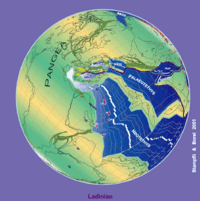Triassic facts for kids
The Triassic is the first geological period in the Mesozoic era and the seventh period of the Phanerozoic eon. It lasted 50.6 million years. The period began 251.9 million years ago, and ended 201.3 million years ago.
The period before the Triassic was the Permian period, the last period in the Palaeozoic era. The Jurassic period came after the Triassic.
Many new groups arose during the Triassic period, including the dinosaurs and the first mammals.
Contents
Extinction events
Great extinction events happened at both the beginning and end of the Triassic period. The Triassic began after the great extinction at the end of the Palaeozoic era, the Permian/Triassic extinction event. Nobody really knows the exact cause of the Permian/Triassic extinction, but many experts have different theories. Generally, experts agree that many things caused the extinction.
The Triassic had several more extinction events, whose causes are also unknown. The most significant of these took place at the end of the Triassic, which was one of the 'big five' Phanerozoic marine extinctions.
Geology
Name
The name 'Triassic' comes from the three rock strata that formed during the Triassic period ("tri" means "three"). Three layers of rock strata formed during this period:
- Red beds, laid down in desert conditions;
- Limestone, laid down in seas, mostly over continental shelves; and
- Black slate, laid down in rich organic conditions such as river deltas.
Overall climate
On average, the Triassic's climate was very different from today's:
-
- It had about 80% of today's oxygen levels
- There was about six times as much carbon dioxide in the air as there was before the Industrial Revolution
- The Earth's average surface temperature was about 3o C hotter than it is now
Paleogeography
During the Triassic period, there were no separate continents like there are today. Almost all the Earth's land mass was together in a single supercontinent called Pangaea ("all the land"). Pangaea was centered more or less on the equator. All the deep-ocean sediments (the things that settled at the bottom of the ocean) had disappeared. This happened because oceanic plates moved sideways and downward until they were finally on top of each other, or under each other.
The supercontinent Pangaea was rifting during the Triassic – especially late in the period – but had not yet separated into different continents.
Being a super-continental land mass, Pangaea had limited shoreline. Because of this, Triassic marine deposits – fossils from Triassic ocean life – are rare in most of the world. In North America, for example, marine deposits are limited to a few exposures in the west. However, they are common in Western Europe, where the Triassic was first studied.
Major adaptive radiations
The first part of the Triassic had much less variety than the Permian, and showed signs of a deteriorated environment. This situation lasted for about 5 million years, then steadily improved. Into the vacant ecological niches, new forms evolved, replacing old with new. This rapid adaptive radiation happened to the reptiles on land, the fish in the seas, and a number of other groups, like the insects. Diverse communities with complex ecology took 30 million years to re-establish.
Fish
The group of bony fish known as the teleosts first appeared during the Triassic period. The group now includes over 80% of all fish and 95% of all bony fish. The only other common group of fish are the Chondrichthyes (the sharks and rays). The rays also appeared during the Triassic.
Reptiles
Many reptile groups first appeared during the Triassic period, possibly because so many niches were vacant at the time. Some of these new groups died out in the End–Triassic extinction event, but those that survived ruled the Earth for the rest of the Mesozoic. Examples include:
- The Archosaurs, including dinosaurs and crocodiles
- Pterosaurs
- Ichthyosaurs
- Turtles
- Plesiosaurs
This was a major change, because in the middle Triassic period, the Synapsids (mammals' ancestors) were still dominant.
The end-Triassic extinction
Many reptile groups became extinct during the Triassic, including:p. 41
- Crocodilian Archosaurs:
- Ornithosuchids
- Aetosaurs
- Rauisuchians
- Other Archosaurs:
- Euparkeria
- Erythrosuchids
- Proterosuchids
- Proto-Archosaurs
- Rhyncosaurs
- Trilophosaurs
- Prolacertiforms
- Anapsids
- Protocolophonids
Also, amongst the Synapsids (which used to be called mammal-like reptiles), the Dicynodonts died out during the end-Triassic extinction.p. 41
The Triassic was a period of great change in tetrapods: many new and important groups appeared, but many others became extinct. Of all the periods in the Mesozoic era, there are the least number of fossils from the Triassic period. This makes it difficult for scientists to explain these events.
Related pages
Images for kids
-
Marine vertebrate apex predators of the Early Triassic
-
Immediately above the Permian–Triassic boundary the glossopteris flora was suddenly largely displaced by an Australia-wide coniferous flora.
-
Staurikosaurus feeding on a dicynodont, in geopark Paleorrota
-
Cynognathus was a mammal-like cynodont from the Early Triassic. The first true mammals evolved during this period
-
Plateosaurus was an early sauropodomorph, or "prosauropod", of the Late Triassic
-
Coelophysis, one of the first dinosaurs, appeared in the Late Triassic
-
Life reconstruction of Tanystropheus longobardicus
See also
 In Spanish: Triásico para niños
In Spanish: Triásico para niños











